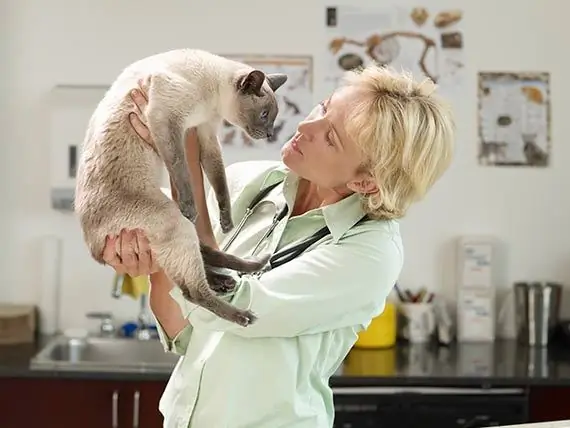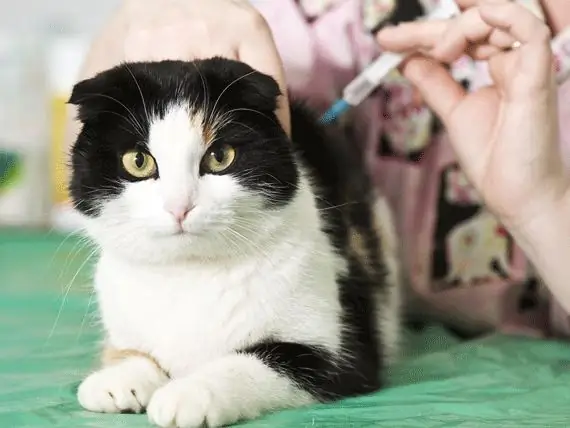
- Autor Daisy Haig [email protected].
- Public 2023-12-17 03:07.
- Viimati modifitseeritud 2025-06-01 06:47.
Mis see piinlik kakaatest siis ikkagi on?
See on piisavalt stressirohke, kui teie lemmiklooma tagakülge rikub plastvarras, eks? Mis mõte siis on?
Te ütlete: kui eesmärk on muuta minu lemmikloom tervislikumaks ja parasiidivabaks, siis ma usaldan teie otsust, kuid pean ütlema, et väljaheite kontroll on omamoodi julm ja ebatavaline karistus. Ma ei saa sellist alandust enne, kui olen mees ja nelikümmend, eks? Ja väljaheited pole nii kasulikud, eks?
Ma ütlen: Alustuseks ei pea te oma lemmiklooma õelale vardale alla andma. Värske proovi saab tavaliselt kergesti hommikul (või pärastlõunal) enne iga-aastast külastust või siis, kui teie lemmikloomal on seedetrakti sümptomeid. Tegelikult pole see nii karm. Ja kui ajastus pole täpselt õige (parimate tulemuste saavutamiseks ei tohiks väljaheide olla vanem kui tund), ei keela teie loomaarstihaigla kindlasti teie õigust tuua endale värske proov. Lubage.
Ja jah, fekaaliuuringud on küll hädavajalikud, ehkki suhteliselt odavad ja rutiinsed. Kuid nagu see postitus näitab, on tõsi ka see, et mitte kõik fekaalitestid ei tõsta teie lemmikloomadel parasiitnakkust. Seetõttu võib osutuda vajalikuks iga-aastased ja / või järjestikud fekaalide uuringud.
Nüüd katse peamine eesmärk:
Veterinaararstid otsivad alati parasiite, kes võivad sattuda teie lemmikloomade seedetrakti. Muidugi, ka meie, inimesed, võime saada parasiite, kuid meie tänapäevane eluviis on parasiitide nakatumist vähem soodustav. (Millal sa viimati käisid hoovis, huuled vastu maad, nuuskimas, et saaksid sisse hingata kassiheina või kahte?)
Jah, lemmikloomad saavad palju parasiite. Siin on proov kõige tavalisematest seedetrakti parasiitidest, mida siin näen [parasiiditaevas, mis on pooltroopiline Lõuna-Florida]:
Ümarussid koertel ja kassidel.
Haakussid lemmikloomadel
Piitsussid lemmikloomadel
Giardia lemmikloomadel

Lemmikloomadel tekivad maksakoored
Lemmikloomadel tekivad maksakoored
coccidia in pets
i’ll not go into the gory details on each but you can click on the links and check out the info for a better understanding of how these parasites can potentially affect your pets and even your human family.
sure, pet-popular parasites don’t often infect humans in the so-called, “developed” nations all of you reading this likely live in, but that doesn’t mean it doesn’t happen. roundworms and hookworms are still a factor in humans in the us, as is giardia, which will give you the nastiest case of diarrhea you can imagine short of amoebic dysentery.
since veterinarians are also on the front lines when it comes to public health, consider that fecal exams are not just necessary for healthy pets, they’re essential for healthy humans, too, more so if your family members are very young children, very old adults or otherwise immunocompromised (transplant patients, hiv-positive humans, chemo recipients, etc.).
how do we identify these critters in the fecal exam?
the short answer: with a microscope.
the long answer: we take a tiny sample of your pet’s stool (very fresh is always best). a few grams is enough (think an eighth of a teaspoon if that’s easier). then we put it through one of three processes.
1. the smear: we take about a half gram of stool and smear it onto a microscope slide to search for parasites (and bacteria) directly. many times we’ll see them swimming about. finding evidence of parasites in a simple smear is often indicative of severe infection.
2. the float: this method relies on mixing the stool with a special solution. it filters out the big pieces of stool in a tube or other cylindrical vessel and allows the eggs and other small critters to float up to the top, buoyed by the solution’s specific gravity. a microscope slide’s cover slip is typically used to recover the floaters. some parasites, however, aren’t amenable to flotation. eggs seem to do best through this method.
3. centrifugation: spinning the heck out of stool in a centrifuge when it’s mixed in a sugar solution picks up about 50% more parasite eggs and oocysts than through flotation. therefore, i like this method best for worm eggs, giardia, and coccidia--though i’d never go without a smear. problem is, most hospitals don’t yet use this method. it’s more expensive than others and research demonstrating it’s much greater efficacy is fairly recent.
so now you know the truth: not all fecal exams are created equal. not only does this test rely on careful selection of materials and methods, it also requires a trained eye. in our practice, for example, one of our techs detects parasites about 50% more often than the veterinarians and other techs/assistants. (that’s why we also do floats so that she can check them all at her convenience when she comes back from her day off.)
it’s also true that even a parasite-infected animal will often not come up positive on a fecal test. human error and equipment choice are factors, but so is the parasite itself. sometimes they do not make themselves known in the stool. worms sometimes aren’t shedding their eggs and subclinical (low-grade or smoldering) infections may not reveal much, either.
again, that’s why it’s important to perform this test as often as is reasonable. for all dogs and cats at least three times during the first few months of life. i want to see at least two negative tests in a row, a month apart, before i’ll feel comfortable that my patient is parasite-free.
for adults, once a year is great--that is, unless they show gastrointestinal illnesses. in this case, serial fecal tests make sense--or at least one every time the symptoms recur until a definitive diagnosis is made (whether it’s parasites or something else).
ultimately, fecal tests are a critical component of our veterinary hat of tricks. doing without may seem like the economically wisest thing in the absence of gastrointestinal symptoms, but consider: parasites can wear pets down in ways you might not expect. and it’s never wrong to be too safe in the presence of diseases that may also affect your family. ‘nuff said.
Soovitan:
6 Asja Teie Majas, Mis Võivad Vallandada Teie Lemmiklooma Allergia

Lemmikloomade allergia võib olla keeruline probleem, eriti kui te ei saa aru, mis neid põhjustab. Uurige, millised 6 asja teie kodus võivad tegelikult olla teie lemmiklooma allergiate põhjused
Kui Ohutud On Lemmikloomadele Murukemikaalid? - Kas Teie Ideaalne Muru Tapab Teie Lemmiklooma?

Kui ameeriklased püüdlevad täiusliku rohelise muru poole, kasutavad nad eesmärkide saavutamiseks mitmesuguseid kemikaale. Kahjuks on sellel kahjulik mõju keskkonnale ja selles elavatele loomadele. Kuidas muru- ja aiasaadused meie lemmikloomi mõjutavad? Loe rohkem
Kuidas Teie Loomaarst Teie Lemmiklooma Prognoosi Määrab

"Kui keskendume liiga palju konkreetsetele prognostilistele teguritele, kaotame suurema pildi silmist." Enne patsientide hoolduse kohta soovituste andmist keskendub dr Intile meelde, et iga loom on ainulaadselt loodud organism ja tuleb kaaluda paljusid tegureid. Lisateavet oma lemmiklooma "prognostiliste tegurite" ja selle kohta, kuidas need ravi määravad, leiate tänasest Daily Vetist
Mida Veretöö Teie Loomaarstile Teie Lemmiklooma Tervisest Räägib

Veretöö tehakse selleks, et tagada, et oleme seestpoolt sama terved kui väljastpoolt, või jälgida eelnevalt diagnoositud terviseseisundeid. Sama lugu on ka kaasloomadega. Lisateave selle kohta, mida veretöö võib teie loomaarstile öelda
Lemmiklooma Majutamine Vs Lemmiklooma Istumine - Mis On Teie Lemmiklooma Jaoks Parem

Äri, puhkuse, pulmi või perekonna kokkutulekuks peate minema linnast välja. Kas teie suurim mure on reisiplaanid või mida teha koera ja kassiga? Kas tal läheb teiste loomade ja igapäevase mänguaega kõrval parem jooks? Või on ta võõras keskkonnas liiga kartlik ja sotsiaalselt ettearvamatu ning tal oleks kodus parem? Majutus või lemmiklooma istumine, mis on kõigi osapoolte jaoks vähem stressirohke?
